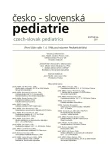Off-label prescribing in pediatrics
Authors:
P. Langerová; K. Urbánek
Authors‘ workplace:
Ústav farmakologie LF UP a FN, Olomouc
přednosta prof. RNDr. P. Anzenbacher, DrSc.
Published in:
Čes-slov Pediat 2011; 66 (6): 380-386.
Category:
Review
Overview
In daily practice it is difficult to find drugs licensed for use in children, therefore many drugs are prescribed in doses or routes of administration and for conditions not approved in the marketing authorization. About 70% of drugs prescribed to the pediatric population are prescribed off-label or unlicensed. It is important to stress the fact that off-label is not synonymous with incorrect. The quality of drug therapy is not necessarily related to drug license status. On the other hand, the risk of adverse drug reactions is 3.6-fold higher in children and adolescents receiving off-label drugs in the hospital setting and 2-fold higher in the outpatient setting. Recent studies also show a relationship between off-label and unlicensed drug prescribing and the age. The younger the child, the more likely he/she is to get an off-label or unlicensed drug prescription. This is typical mainly for the hospital care. In outpatient setting, there is a higher rate of prescription of these drugs in adolescents. There is only a slight difference between countries where studies were done.
The drugs most commonly used off-label or unlicensed are cardiovascular drugs. To avoid exposing children to unnecessary risks and to avoid depriving them of potentially effective pharmacotherapy, an amendment of legislation to facilitate and encourage pediatric clinical trials is needed.
Key words:
off-label, unlicensed, drugs, children, pediatrics, clinical studies, prescriptions, hospitals
Sources
1. Chessels JM. Treatment of childhood acute lymphoblastic leukaemia: present issues and future prospects. Blood Rev 1992; 6: 193–203.
2. Roberts R, Rodriguez W, Murphy D, Crescenzi T. Pediatric drug labeling: improving the safety and efficacy of pediatric therapies. JAMA 2003; 290(7): 905–911.
3. Caldwell PH, Murphy SB, Butow PN, Craig JC. Clinical trials in children. Lancet 2004; 364(9436): 803–811.
4. Turner S, Longworth A, Nunn AJ, Choonara I. Unlicensed and off label drug use in paediatric wards: prospective study. BMJ 1998; 316(7128): 343–345.
5. Pandolfini C, Bonati M. A literature review on off-label drug use in children. Eur J Pediatr 2005; 164(9): 552–558.
6. European Medicines Agency. The European paediatric initiative: History of the Paediatric Regulation. Doc. Ref: EMEA/17967/04 Rev 1, London 2007.
7. Lindell-Osuagwu L, Korhonen MJ, Saano S, Helin-Tanninen M, et al. Off-label and unlicensed drug prescribing in three paediatric wards in Finland and review of the international literature. J Clin Pharm Ther 2009; 34(3): 277–287.
8. ‘t Jong GW, Vulto AG, de Hoog M, Schimmel KJ, et al. A survey of the use of off-label and unlicensed drugs in a Dutch children’s hospital. Pediatrics 2001; 108: 1089–1093.
9. ‘t Jong GW, van der Linden PD, Bakker EM, van der Lely N, et al. Unlicensed and off-label drug use in a paediatric ward of a general hospital in the Netherlands. European Journal of Clinical Pharmacology 2002; 58: 293–297.
10. Bajcetic M, Jelisavcic M, Mitrovic J, Divac N, et al. Off label and unlicensed drug use in paediatric kardiology. European Journal of Clinical Pharmacology 2005; 61: 775–779.
11. Di Paolo ER, Stoetter H, Cotting J, et al. Unlicensed and off-label drug use in Weiss paediatric university hospital. Swiss Medical Weekly 2006; 136: 218–222.
12. Conroy S, Newman C, Gudka S. Unlicensed and off label drug use in acute lymphoblastic leukaemia and other malignancies in children. Ann Oncol 2003; 14: 42–47.
13. Hsien L, Breddemann A, Frobel AK, Heusch A, et al. Off-label drug use among hospitalised children: identifying areas with the highest need for research. Pharm World Sci 2008; 30(5): 497–502.
14. Bazzano AT, Mangione-Smith R, Schonlau M, Suttorp MJ, Brook RH. Off-label prescribing to children in the United States outpatient setting. Acad Pediatr 2009; 9(2): 81–88.
15. Hsu B, Brazelton T. Off-label medication use in an academic hospital pediatric critical care unit. Department of Pediatrics, University of Wisconsin School of Medicine and Public Health, Madison, WI 53792-4108, USA. MJ 2009; 108(7): 343–348.
16. Bavdekar SB, Sadawarte PA, Gogtay NJ, Jain SS, Jadhav S. Off-label drug use in a Pediatric Intensive Care Unit. Indian J Pediatr 2009; 76(11): 1113–1118.
17. Phan H, Leder M, Fishley M, Moeller M, Nahata M. Off-label and unlicensed medication use and associated adverse drug events in a pediatric emergency department. Pediatr Emerg Care 2010; 26(6): 424–430.
18. Doherty DR, Pascuet E, Ni A, Stewart P, Splinter W, Vaillancourt R. Off-label drug use in pediatric anesthesia and intensive care according to official and pediatric reference formularies. Can J Anaesth 2010; 57(12): 1078–1088.
19. Porta A, Esposito S, Menson E, Spyridis N, Tsolia M, et al. Off-label antibiotic use in children in three European countries. Eur J Clin Pharmacol 2010; 66(9): 919–927.
20. Kemper EM, Merkus M, Wierenga PC, Van Rijn PC, Van der Werff D, et al. Towards evidence-based pharmacotherapy in children. Paediatr Anaesth 2011 Mar; 21(3): 183–189. doi: 10.1111/j.1460-9592.2010.03493.
21. Hanulík V, Sedláková MH, Petrželová J, Kolář M. Možnosti fluorochinolonů v současné klinické praxi. Klin Farmakol Farm 2010; 24(4): 184–186.
22. Clavenna A, Bonati M. Adverse drug reactions in childhood: a review of prospective studies and safety alerts. Arch Dis Child 2009; 94(9): 724–728.
23. European Medicines Agency. The European paediatric initiative: History of the Paediatric Regulation. Doc. Ref: EMEA/17967/04 Rev 1, London 2007.
Labels
Neonatology Paediatrics General practitioner for children and adolescentsArticle was published in
Czech-Slovak Pediatrics

2011 Issue 6
Most read in this issue
- Necrotizing enterocolitis in full-term neonates. Case report and review of the literature
- Off-label prescribing in pediatrics
- Changes in electrical conductivity of the skin due to painful stimuli in newborns of different gestational categories and comparison with changes in selected physiological parameters
- The development of neonatal care and evaluation of the first five years experience in surgery of cleft lip in the neonatal period
